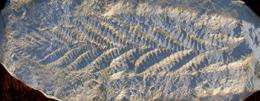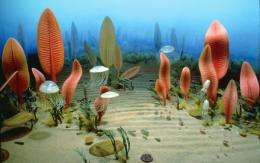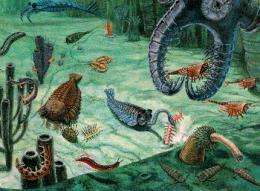Fossils on the Edge of Forever

Astrobiologists have not yet found alien life on other planets. But the fossil record has evidence of aliens of another sort: the Ediacarans that lived on Earth millions of years ago.
This year marks two important anniversaries in the history of the study of life on Earth: the birth in 1919 of the geologist Reginald Sprigg, and the death in 1989 of the palaeontologist Martin Glaessner. Both of these men spent large portions of their careers working on some of the most enigmatic creatures in the fossil record - the Ediacarans - a group of multicellular organisms that lived for a relatively narrow slice of time between 575 and 542 million years ago during the Ediacaran period (whose span was formally defined in 2004 as encompassing the interval between 635 and 542 million years ago). The fleeting existence of the Ediacaran biota occurred just before the rise of complex animal life.
In the years immediately following the end of the Second World War, Sprigg was prospecting for uranium to feed Britain’s nascent atomic bomb program. He searched the hills of the Flinders Range some five hundred miles north of Adelaide, Australia. The low-angled sunlight threw the surrounding rocks into stark relief, and Sprigg noticed some peculiar dimples and indentations in the rock. Further work revealed that they were impressions of strange soft bodied organisms, and that the rock could be dated unequivocally as Precambrian. It was an astonishing discovery because it proved that the “deep time” fossil record that Darwin had been so anxious to find did, after all, exist.
Only a few years later the British schoolboy Roger Mason found examples of these same animals in the rocks of Charnwood Forest in Leicestershire, England. Both the Australian and British fossils had been deposited on the margins of ancient supercontinents.
In the fifty years since Sprigg discovered the Ediacarans, they have been the subject of intense research. Martin Glaessner was the man most responsible for their detailed description, yet he remained convinced they were the ancestors of modern animals - a view that, in the light of recent studies, has been shown to be probably incorrect. The Ediacarans offer a vital glimpse into the early history of life on Earth. In a way, they are representatives of an alien world - separated from us not by distance, but rather by time.
So what exactly were the Ediacarans? They had no mouth, no gut and no anus. In other words, they have none of the characteristics of the bilaterian animals, which evolved during the Cambrian explosion 542 million years ago. Since then, bilateral animals have provided the basic body plan for every animal that has occupied and dominated the Earth.
Since Ediacarans lacked the feeding-related organ systems of bilateral animals, how did they feed? The answer may lie in the squashed appearance of the Ediacarans. Some have suggested that Ediacarans were osmotrophs, extracting their nutrients directly from the seawater. This, in turn, may be related to the radical changes in the Earth's environment which started at about 600 million years before present, when giant world-girdling ice sheets receded.
Ediacarans looked like sacks of mud, disks, hubcaps and mattresses -- a range of body forms which were never seen again in the fossil record. They were alien. In the fifty years since Sprigg discovered them, the sheer strangeness of the Ediacarans has made some scientists want to put them in their own taxonomic kingdom. The German palaeontologist Adolph Seilacher suggests that the term “Vendobionta” be used to encompass all the Ediacarans.

Another oddity about the Ediacaran organisms was the way in which they are preserved in the fossil record. It is almost an article of faith among palaeontologists that soft-bodied organisms are found in fine grained sediments deposited under quiet conditions. But the Ediacarans that were found in the Flinders Range by Sprigg, as well as those that were found in Charnwood Forest by Mason, were preserved in coarse sandstones - a very unusual rock type in which to find fossils. It was not until 1967 - when the palaeontologist S. B. Misrah discovered Ediacaran fossils preserved in fine-grained mudstones in the Mistaken Point section of Newfoundland - that these strange and enigmatic fossils were found in the type of lithology that was expected. The Ediacaran biota is today known globally from all continents of the world and from all rock types, implying that they must have had a global geographic distribution. This is turn begs the question; if they were so globally successful, where did they come from and why did they disappear so suddenly?
It is likely that they appeared when they did for two related reasons. Recent work on chromium isotopes has shown that there were two pulsed increases in atmospheric oxygen in the late Proterozoic. One occurred between 2.45 and 2.2 billion years before present, and increased atmospheric oxygen as well as oxygen in the shallow ocean. Then, between 0.8 and 0.542 billion years ago, there was another increase in atmospheric oxygen which this time ventilated the deep oceans.
It is drummed into all young palaeontologists (and I was one) that proximity of events in the fossil record does not necessarily imply causality. And yet in the case of the Ediacarans, it seems perverse to ignore this extraordinary coincidence. Given the timing of the second oxygenation event, it seems improbable that the rise in the oxygen level was not in some way related to the rise of the Ediacarans - not least because it would have enabled oxygen to diffuse across the surfaces of their bodies, thereby allowing respiration.
The other reason the Ediacarans appeared when they did is probably due to the removal of an evolutionary bottleneck - the Cryogenian series of Snowball Earth glaciations.
The time period immediately preceding the Ediacaran Period is called the Cryogenian Period for good reason. It is a time when ice sheets are thought to have extended as far as the equator. This is the so-called Snowball Earth hypothesis [www.astrobio.net/video/Podcast_16.mp3]. Although we know that some organisms survived Snowball Earth without any difficulty (for example, sponges as well as red and green algae, which are all more ancient than the Ediacarans) it may be that a world girdled in ice can’t support complex multicellular organisms. If this is the case, then complex animal life could only evolve when environmental conditions became more hospitable.

So why - if they became lords of creation just about as soon as conditions allowed - did the Ediacarans endure for only about sixty million years (roughly the same length of time that separates us from the dinosaurs)? By contrast their successors, the bilaterian triploblasts (which evolved contemporaneously with the Ediacarans), have lasted 542 million years so far and are still going strong.
A suggestion which may explain this also relates to the question of why the Ediacarans left behind their soft-body impressions in coarse-grained rock types. It has been suggested that the Ediacarans lived their lives in association with microbial mats - the kind of things that you might find today in the corner of a shower room that hasn’t seen bleach in a while. Palaeontologists think that such microbial mats may have enhanced the preservation potential of the Ediacaran organisms by stabilizing them after death, allowing them to leave their impressions in the sand on which they lived. They also think that there may have been some kind of symbiotic relationship between the microbial mats and the Ediacarans themselves. With the rise, during the Cambrian explosion, of the bilaterian animals with their new innovations of mouths, feeding appendages and through-guts, these microbial mats were easy, non-mobile prey. Their demise damaged the Ediacaran ecosystem so badly that the Ediacarans themselves became extinct.
Finally, how diverse were the Ediacarans compared to modern animals? In 2008, Bing Shen of the Department of Geosciences, Virginia Polytechnic Institute and colleagues used a more sophisticated metric than simple species richness to gauge the diversity of the Ediacarans.
They found that while the Ediacarans did not occupy the same ecological niches as animals based on the bilaterian body plan, the ecological space that they did occupy was taken over early in their evolutionary history. The first pulse of Ediacaran radiation - the so-called Avalon assemblage - filled many of the niches of the environment that the beasts would ever fill, even though the species richness fluctuated in the two later assemblages - the White Sea and Nama assemblages.
So what can the story of the Ediacarans tell us about the evolution of life on other planets? First and perhaps most importantly, it tells us that evolution can happen very quickly. The idea - first credited to Darwin - that vast amounts of deep time are required for evolution to occur may not be correct. The speed with which the Ediacarans arose in the aftermath of the final Cryogenian glaciation suggests strongly that the evolution of complex, multicellular organisms was on the blocks and just waiting for the starting pistol.
Secondly, we have learned that the process of fossilization is not necessarily relegated to only certain types of rocks. Fossils may well be found on other planets such as Mars, which is believed to have had an environment similar to Earth’s early in its history. Thirdly, the fact that sponges and red and green algae persisted through the Snowball Earth suggests that it's quite feasible that organisms could live under ice - as has been suggested may be the case on Jupiter’s moon, Europa.
The story of the Ediacarans then is clear: we have within the evolutionary history of our own planet a laboratory in which to test theories of the ecology and likely evolutionary history of planets yet to be explored.
More information: Frei, R., Gaucher, C., Poulton, S. W. and Canfield, D. E., 2009. Fluctuations in Precambrian atmospheric oxygenation recorded by chromium isotopes. Nature, 461, 250-254.
Source: Astrobio.net, Richard Corfield


















